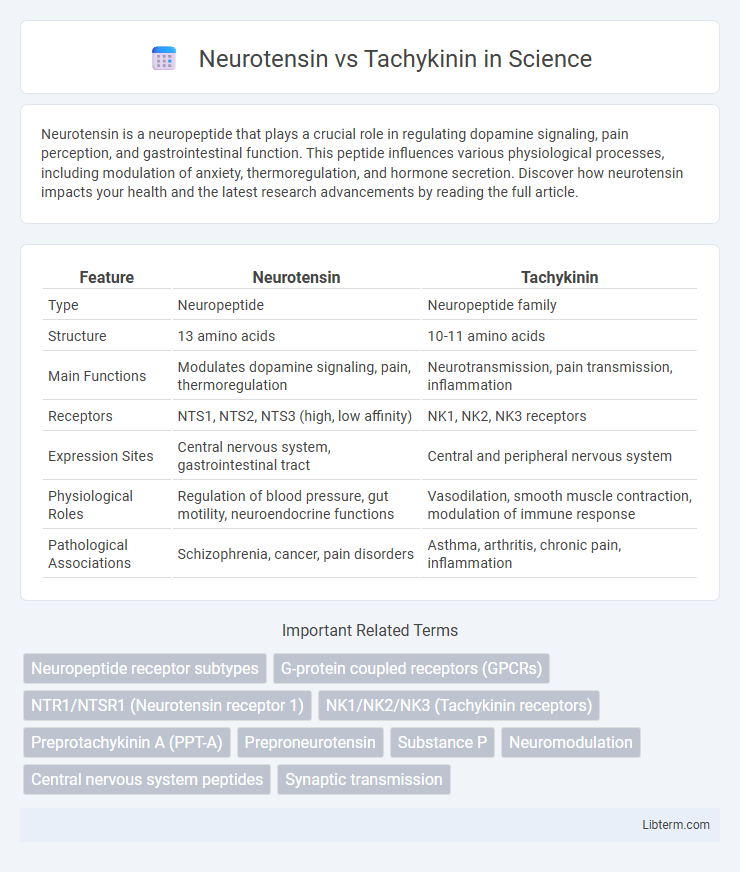Neurotensin is a neuropeptide that plays a crucial role in regulating dopamine signaling, pain perception, and gastrointestinal function. This peptide influences various physiological processes, including modulation of anxiety, thermoregulation, and hormone secretion. Discover how neurotensin impacts your health and the latest research advancements by reading the full article.
Table of Comparison
| Feature | Neurotensin | Tachykinin |
|---|---|---|
| Type | Neuropeptide | Neuropeptide family |
| Structure | 13 amino acids | 10-11 amino acids |
| Main Functions | Modulates dopamine signaling, pain, thermoregulation | Neurotransmission, pain transmission, inflammation |
| Receptors | NTS1, NTS2, NTS3 (high, low affinity) | NK1, NK2, NK3 receptors |
| Expression Sites | Central nervous system, gastrointestinal tract | Central and peripheral nervous system |
| Physiological Roles | Regulation of blood pressure, gut motility, neuroendocrine functions | Vasodilation, smooth muscle contraction, modulation of immune response |
| Pathological Associations | Schizophrenia, cancer, pain disorders | Asthma, arthritis, chronic pain, inflammation |
Introduction to Neurotensin and Tachykinin
Neurotensin is a 13-amino acid neuropeptide involved in modulating dopamine signaling, pain perception, and thermoregulation, primarily found in the central nervous system and gastrointestinal tract. Tachykinins represent a family of neuropeptides, including substance P, neurokinin A, and neurokinin B, which bind to neurokinin receptors (NK1, NK2, NK3) to regulate processes such as inflammation, pain transmission, and smooth muscle contraction. Both neurotensin and tachykinins play crucial roles in neurophysiological functions, exhibiting distinct receptor interactions and signaling pathways that influence diverse biological responses.
Chemical Structure Comparison
Neurotensin is a tridecapeptide composed of 13 amino acids with the sequence pGlu-Leu-Tyr-Glu-Asn-Lys-Pro-Arg-Arg-Pro-Tyr-Ile-Leu, characterized by amidation at the C-terminal end, enhancing receptor affinity. Tachykinins, including substance P and neurokinin A, are distinguished by the conserved C-terminal motif Phe-X-Gly-Leu-Met-NH2, where X is often an aromatic or aliphatic residue, critical for receptor binding and activation. The key chemical distinction lies in neurotensin's unique peptide length and sequence specificity versus the shorter, conserved tachykinin sequence, reflecting divergent receptor interactions and biological functions.
Biosynthesis and Release Mechanisms
Neurotensin is synthesized as a precursor protein, proneurotensin, which undergoes proteolytic cleavage in neurosecretory vesicles primarily within the hypothalamus and gastrointestinal tract, followed by calcium-dependent exocytotic release. Tachykinins, including substance P and neurokinin A, are derived from the preprotachykinin A gene through alternative splicing, with biosynthesis occurring in sensory neurons and released upon depolarization-triggered calcium influx. Both neuropeptides utilize distinct intracellular pathways for vesicular packaging and exhibit stimulus-dependent secretion, but neurotensin release is often linked to neuroendocrine signaling, whereas tachykinins predominantly modulate inflammatory and nociceptive responses.
Receptor Types and Distribution
Neurotensin primarily binds to three receptor subtypes: NTS1, NTS2, and NTS3, with NTS1 and NTS2 being G-protein-coupled receptors predominantly expressed in the central nervous system regions like the hypothalamus and limbic system, while NTS3 is a sorting receptor found in various tissues. Tachykinins interact with neurokinin receptors NK1, NK2, and NK3, all G-protein-coupled receptors with NK1 widely distributed in the brain, spinal cord, and peripheral tissues, mediating pain and inflammation. The distinct but overlapping receptor distributions of neurotensin and tachykinins contribute to their roles in modulating neurological and inflammatory processes.
Physiological Functions of Neurotensin
Neurotensin primarily modulates dopamine transmission, regulates body temperature, and influences pain perception through its action in the central nervous system. It also plays a significant role in gastrointestinal functions by promoting intestinal motility and stimulating pancreatic secretions. Unlike tachykinins, which mainly mediate inflammatory responses and smooth muscle contraction, neurotensin exerts a broader spectrum of neuroendocrine and metabolic effects.
Biological Roles of Tachykinins
Tachykinins, such as substance P, neurokinin A, and neurokinin B, primarily function as neurotransmitters and neuromodulators involved in pain transmission, inflammation, and smooth muscle contraction. These peptides activate tachykinin receptors (NK1, NK2, and NK3) to regulate physiological processes including vasodilation, neurogenic inflammation, and stress response. Unlike neurotensin, which mainly influences dopamine pathways and thermoregulation, tachykinins have a broader role in immune response modulation and gastrointestinal motility.
Signal Transduction Pathways
Neurotensin activates primarily G protein-coupled receptors (NTS1, NTS2) leading to phospholipase C (PLC) activation, inositol trisphosphate (IP3) production, and intracellular calcium mobilization, which regulate neurotransmission and cellular proliferation. Tachykinins, such as substance P, bind to tachykinin receptors (NK1, NK2, NK3), triggering Gq/11 protein signaling cascades that stimulate PLC, increase IP3 and diacylglycerol (DAG), and activate protein kinase C (PKC), affecting pain perception and inflammation. Both peptides modulate diverse physiological responses via distinct but overlapping GPCR-mediated signal transduction pathways critical for nervous and immune system functions.
Neurological and Systemic Effects
Neurotensin modulates neurotransmission and influences dopamine signaling, playing a critical role in pain perception, thermoregulation, and neuroendocrine functions. Tachykinins, including substance P, primarily mediate neurogenic inflammation and nociception by activating NK1 receptors, impacting both central and peripheral nervous systems. Both peptides contribute to systemic effects such as vasodilation and immune response modulation, but neurotensin is more involved in metabolic regulation while tachykinins predominantly influence inflammatory pathways.
Clinical Implications and Therapeutic Potentials
Neurotensin and tachykinins, both neuropeptides, play critical roles in modulating pain, inflammation, and neurodegenerative disorders, with neurotensin showing promise in antipsychotic and analgesic therapies through its modulation of dopamine pathways. Tachykinins, including substance P, are implicated in inflammatory diseases and pain management, making their receptors prime targets for treating asthma, depression, and chronic pain. Advances in receptor-specific agonists and antagonists highlight the therapeutic potential of these peptides in personalized medicine for neurological and inflammatory conditions.
Future Research Directions
Future research on neurotensin and tachykinin should concentrate on elucidating their distinct receptor subtypes and signaling pathways to develop targeted therapeutics for neurological disorders. Investigating the role of neurotensin in modulating dopamine transmission and tachykinin's involvement in neuroinflammation could reveal novel treatment strategies. Advanced techniques like CRISPR gene editing and in vivo imaging will enhance understanding of their functions in pain regulation and psychiatric conditions.
Neurotensin Infographic

 libterm.com
libterm.com